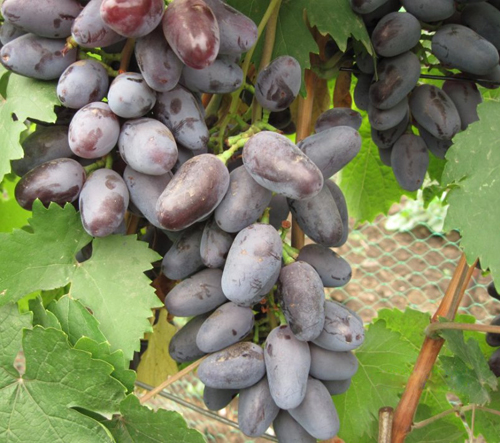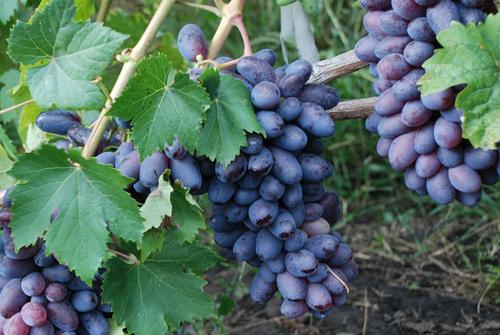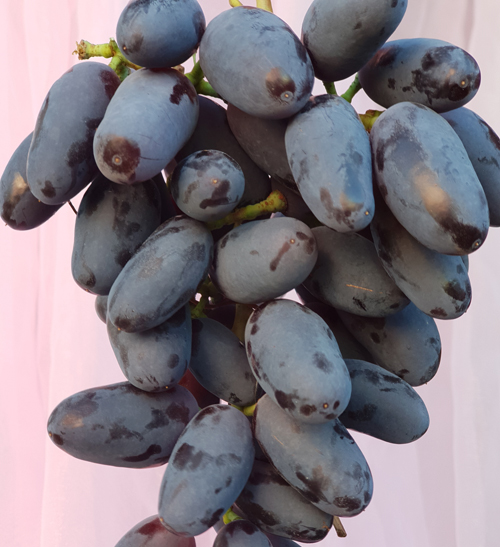Baikonur grape variety
Baikonur grapes are one of the promising novelties from the famous representative of amateur selection E.G. Pavlovsky. Evgeny Georgievich began to develop new varieties for a long time - since 1985, after getting acquainted with the work of professional scientists from VNIIViV them. ME AND. Potapenko. This activity turned out to be so exciting and interesting that the talented author over the years presented winegrowers with many hybrid forms that have already become popular, a number of which were even awarded the entry into the State Register of Breeding Achievements of the Russian Federation. And although Baikonur, presented to the public in 2012, is not yet ready to boast of such success, it is rapidly gaining popularity among amateurs, receiving praise from various parts of Russia and the CIS countries.

The new variety was obtained by Pavlovsky on the basis of crossing the variety Mascot (popular among folk breeders for its good resistance to diseases and a convenient, functionally female type of flower to work with) and its own hybrid called Krasotka. The latter was bred by him earlier by pollination of the famous Victoria variety with a mixture of pollen from the European-Amur forms of grapes.
Baikonur is distinguished by an attractive appearance of elongated bunches with large dark-colored berries, which have good taste and early ripening, as well as strong growth of bushes capable of accumulating a large supply of perennial wood. So far, we can speak about the agrotechnical features of the hybrid only on the basis of the reviews of the “pioneers”, since there is no objective data on resistance to diseases, pests and frost yet. However, the enthusiastic comments of those who have already planted a new variety on their site leave no doubt that this grape has a future.
Agrobiological characteristics
The growth force of the Baikonur vine is high. With good preparation of the site and quality planting, you can literally form a bush skeleton in two seasons, and in the third, get the first, so-called "signal" clusters. Crowns of young shoots are green with a bronze sheen of varying intensity. The leaves are large, five-lobed, slightly elongated in length, reticulate-wrinkled, moderately dissected. The lower surface of the leaf blade is pubescent. The upper lateral notches are deep, open, lyre-shaped with a narrow aperture and a rounded bottom; the lower ones are barely marked. The petiole notch is open, lyre-shaped, with a sharp bottom. The denticles along the edge of the grape leaf are large, triangular with convex sides and a base of medium width. The flower is bisexual, according to reviews, it is well pollinated and does not show a tendency to pea.

The bunches of the variety are massive, with an average weight of 500-1000 grams, cylindrical or cylindrical-conical in shape, often very elongated in length. Loose to moderate density. The berries in the bunch are not squeezed or damaged by each other. The comb and stem of the berries are long, strong, light green in color. The berries are very large, elongated-nipple-shaped, 4-5 cm long and weighing 12-15 grams. The pulp is yellowish-green in color with lilac areas directly under the skin, dense, juicy-fleshy, harmonious taste without pronounced specific aftertaste and aroma. The skin is of medium thickness, very tough, but edible, dark purple in color with a thick, pruned protective coating of a bluish tint on the surface. In the pulp of Baikonur berries, there are usually 2-3 medium-sized seeds that do not have a strong negative impact on the taste of grapes. Thanks to the strong skin of the berries, the bunches can remain on the bushes for a long time after ripening, without being damaged by wasps and leaf rollers. Cracking and decay is possible only under excessively humid weather conditions, or with sudden changes in soil moisture.
The crop is used fresh.The grape has a very attractive appearance, due to which it should be a very popular variety on the market. In addition, in the group of early ripening varieties, it is one of the few specimens with a dark berry color. This fact will also add a certain number of fans to him. Dense pulp and strong skin determine the high transportability of Baikonur and the possibility of its long-term storage without loss of commercial qualities.
The harvest reaches removable maturity within 110 days after the start of the growing season and requires only 2200-2300 ° C of the sum of active temperatures. According to these indicators, the hybrid belongs to the group of very early maturing and is capable of ripening even in the climate near Moscow, which is confirmed by the positive reviews of amateur winegrowers. The yield of Baikonur shows decent, it “pulls out” well even a certain congestion of the bushes, however, in this case it reduces its tasting characteristics. The frost resistance of the variety declared by the author is -23 ° C, which is a good indicator. In practice, so far there are no unambiguous data on this matter.

Grape shoots ripen perfectly, except, again, in cases of excessive overloading of the bushes, when the plant spends a maximum of plastic substances on the formation of the crop. The percentage of fruitful shoots and the number of brushes formed on them are quite high, which determines the tendency of the hybrid to overload. The sugar content of the juice of berries reaches high values - 19-20%, while the acidity is kept at the level of 6-7 grams / liter.
Agrotechnical features
Since the hybrid form is still insufficiently studied, recommendations for its cultivation can be very conditional. In such cases, it is better to play it safe so that, through ignorance, you do not accidentally ruin the crop, or, worse, the whole plant.
The most harmful factors for grapes that can destroy the bushes themselves are excessively low winter temperatures and damage to the root system by phylloxera. Therefore, let's start with them. Baikonur's resistance to phylloxera is completely unknown, therefore, in order not to waste time and effort, in the areas where this pest is spread, it is necessary to propagate the variety exclusively by grafting on resistant rootstocks. Own-rooted culture is possible, and even preferable in places where phylloxera has not yet reached. By the way, cuttings of this hybrid take root very well, giving powerful growths when cultivated on their own roots.
The frost resistance of the variety may also differ from the declared one, therefore, in areas with cold temperatures below -23 ° C, cultivation is carried out only with shelter for the winter, and in milder climatic conditions, it is recommended to use semi-covering forms of bush management. For this, plants are formed from two parts - the main and the reserve. The main part is grown on a trunk according to the traditional for the southern regions non-covering scheme with cordons and sleeves. The reserve one is a lightweight lower tier, sheltered for the winter and serves as insurance in case of death of the main part from frost. From it it will be possible to quickly restore the affected part of the bush at any time.
Fungal diseases of grapes can also pose a serious danger, the resistance of Baikonur to which is also unambiguously unknown. Here you can do different things: either treat the variety with fungicides according to standard protocols for protecting vineyards susceptible to diseases, or become a researcher on your own and determine the resistance of your bushes on your own experience, sensitively reacting to the very first signs of pathologies that have appeared. The choice depends on the literacy of the grower and the availability of at least a basic knowledge of plant protection.
Other, already identified problems should be dealt with traditionally.To prevent crop overload, in the spring during pruning, a moderate number of eyes are left on the plant, depending on the age and degree of development of the bush. On average, this indicator varies from 35 to 45. It is better to choose an average length of pruning for a variety - 6-9 buds per fruit arrow. During green operations, the load is finally regulated, breaking off weak, sterile shoots of grapes, and leaving only one bunch on the fruitful ones.
If to all of the above we add a general improvement of the agricultural background, watering and fertilizing in moderate doses, then there is no doubt that Baikonur will show itself in all its glory, giving the grower an abundant early harvest of beautiful and tasty berries.








